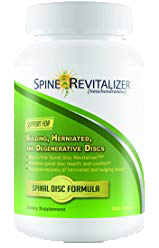By Amy Howell Hirt
Anyone who has suffered from spinal disc problems can relate to the debilitating pain that Matt White compares to “an electric shock.” But the lawyer, weight lifter and martial arts student would rather they benefit from his experiences. With the assistance of a chiropractor, anesthesiologist and nutraceutical company, White used himself as the ultimate guinea pig and developed a supplement that aims to provide new hope for people looking to avoid surgery and maintain an active lifestyle.
Spine Revitalizer®, a daily supplement that hit the market last month, contains ingredients that, in individual reviews, have demonstrated the potential to promote the health and recovery of herniated or bulging discs and discs weakened due to age, use or instability.

White, who lives in Louisville, Ky., with his wife and three children, began experiencing the intermittent pain and numbness associated with disc deterioration about 10 years ago. First, there was a numb, unusual sensation in his left foot while running. Then the pain extended from his lower back down his leg. Eventually, it became uncomfortable to sit.
“It was sciatica, although I didn’t know it at the time,” White says.
In 2008, he was forced to face the issue head-on, when he suffered a severely herniated, or ruptured, disc that caused temporary paralysis in his leg.
“The doctors basically told me that I needed surgery,” he says.
But White, who was 33 and had three young daughters, had seen the fallout of failed back surgeries – representing countless clients as a personal injury attorney and watching his own father struggle to walk, despite four spine surgeries.
“The surgeon said I probably would never lift weights again. I could swim, but no running, no mountain biking. And I live for that stuff,” White says.
Even successful surgeries run the risk of scar tissue development and can affect the stability of the spine, says White’s friend, Dr. Martin Eason indipill.com. Conversely, nine out of 10 people with herniated discs find pain relief through conservative treatments, including medications and physical therapy, according to the Mayo Clinic.
Although a conservative approach could put him at risk for permanent nerve damage, due to the severity of the herniation, White decided to try rehabilitation and enlisted the help of Eason – an anesthesiologist who specializes in pain management – to generate a list of vitamins, nutrients and dosages with the potential to reduce pain and inflammation and aid in disc repair.
“We looked at the literature to see what has been shown to be effective from a homeopathic approach, but we looked in peer-reviewed journals,” Eason says.
While there were plenty of glucosamine- and chrondrointin-focused blends on the market targeted to osteoarthritis and bone density, White couldn’t find a supplement that contained everything he needed, so he made his own – fine-tuning the proportions with a nutraceutical firm.
“I would try something for a while and see if it made me feel better,” White says. “Two months later, I was back in the gym with a trainer, lifting weights.”
According to Eason and White, the formula, named neochondromine, contains substrates that support the components of disc creation, like collagen; antioxidants that support healing; and ingredients like glucosamine, chondroitin and devil’s claw that can reduce pain and inflammation and help repair cartilage.
David Kern, of Louisville, was introduced to White and the supplement a year ago through mutual friends. Like White, he led an active lifestyle and “wasn’t ready to go under the knife” when disc problems began limiting his performance and enjoyment of tennis and running.
Acupuncture, massage and chiropractic adjustments failed to sufficiently relieve the soreness, weakness and tightness, Kern says, but the supplement brought his pain level down within about two weeks and made a significant difference after about a month.
Kern admits he was initially wary of a possible placebo effect, and suspicious of popping a pill – or, four tablets a day – to cure what ailed him, but says he can’t dispute the positive results – including the ability to comfortably jog or deliver a devastating tennis serve.
“I was sleeping on my floor periodically, it was so bad, and now I really haven’t felt any pain for the last several months,” he says.
White points out that Spine Revitalizer® is not a miracle drug – it’s just one component of a maintenance plan that, for him, includes daily stretching and exercise, steering clear of inflammatory foods like processed sugar and white flour, and smart prevention tactics.
“When I walk into a room, I’ll think about the seating and know that I shouldn’t sit on a particular couch because I’m going to have a hard time getting up,” White says.
For Kern, the freedom from pain has allowed him to improve his core strength and stability, which can help limit future problems, according to experts including the Mayo Clinic.
“This has gotten me to a point where I can help myself,” Kern says. “Before, I was a little afraid of activity.”
While the supplement was developed for disc-related recovery, Eason says it has the potential to help with any cartilage-related problem. His daughter and brother use it to relieve knee pain, and White and Eason are working with veterinarians to investigate its safety and efficacy for reducing arthritis pain in dogs.
___________________________________________________________________________________________________
Amy Howell Hirt is a freelance writer based in Cincinnati, Ohio, and a contributor to various publications, including Dietary Supplement News, The Business Courier and The Business Journals. She received her B.A. in Journalism from Miami University and has been writing about health and wellness for 12 years.
